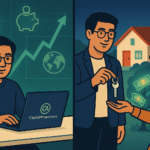In the early 2000s, the idea of a decentralized digital ledger might have sounded like science fiction. Fast forward to 2025, and blockchain technology is no longer just a buzzword confined to tech circles or cryptocurrency fanatics. It’s becoming a foundational innovation reshaping industries, from finance and healthcare to supply chains and even voting systems.
But what exactly is blockchain? Why is it important? And more importantly, how does it affect your daily life or financial decisions? In this beginner-friendly guide, we’ll break down what blockchain is, how it works, and why it matters more than ever in today’s digital age.
What is Blockchain?
Imagine a book that’s constantly being written, page by page, and everyone in the world can read it and verify its content. That’s a simple way to understand what blockchain is. It’s a digital ledger that records transactions in a secure, transparent, and decentralized way.
Each record or “block” contains:
- A timestamp
- A list of transactions
- A unique identifier (called a hash)
- A link to the previous block
These blocks are chained together using cryptographic principles. Once a block is added to the chain, it cannot be changed, making the entire ledger tamper-resistant.
How Blockchain Works: Simplified
- Transaction Initiation: Someone initiates a transaction (e.g., transferring Bitcoin).
- Broadcast to Network: The transaction is broadcasted to a network of computers (nodes).
- Validation: These nodes validate the transaction using consensus algorithms (like proof-of-work or proof-of-stake).
- Block Creation: Once validated, the transaction is grouped with others into a block.
- Block Added to Chain: The block is added to the existing blockchain.
- Permanent Record: The transaction is now permanent, visible, and secure.
No central authority is involved, which reduces the risk of corruption, censorship, and fraud.
Blockchain vs. Traditional Systems
| Feature | Blockchain | Traditional Systems |
|---|---|---|
| Control | Decentralized | Centralized (banks, gov.) |
| Security | Cryptographically secure | Vulnerable to hacks/errors |
| Transparency | Full public ledger | Limited visibility |
| Speed | Varies (can be slower) | Often faster (centralized) |
| Cost | Lower fees in some cases | Higher fees and charges |
Real-World Applications Beyond Crypto
While blockchain made its name with Bitcoin, its uses extend far beyond digital currencies. Here are some real-world applications changing lives today:
1. Supply Chain Transparency
Companies like IBM and Walmart use blockchain to track products from origin to shelf. Consumers can scan a QR code on a mango and know where it was grown, when it was shipped, and how fresh it is.
2. Healthcare Records
Medical records can be securely stored and shared across providers, ensuring patients receive faster and more accurate care while maintaining privacy.
3. Voting Systems
Countries are experimenting with blockchain-based voting systems to reduce fraud, increase transparency, and make elections more accessible.
4. Digital Identity
Blockchain can give people secure digital IDs. For the 1.1 billion people worldwide who lack legal identification, this could be life-changing.
5. Smart Contracts
These are self-executing agreements where terms are coded directly into the contract. No need for middlemen like lawyers or notaries.
Why Should You Care?
Blockchain isn’t just for tech geeks. Here’s how it might impact your life:
- More Control Over Your Money: With crypto wallets and decentralized finance (DeFi), you can lend, borrow, or invest without banks.
- Greater Transparency: From charities to elections, blockchain ensures records can’t be manipulated.
- Digital Ownership: Through NFTs and tokenized assets, you can own unique pieces of digital art, music, or even real estate.
The Pros and Cons of Blockchain
Pros:
- Security: Cryptographic protection against hacking.
- Transparency: Open ledger viewable by all.
- Decentralization: No single point of control or failure.
- Efficiency: Automates tasks, reduces need for intermediaries.
Cons:
- Scalability: Networks can be slow with high traffic.
- Energy Use: Some (like Bitcoin) consume a lot of electricity.
- Regulatory Uncertainty: Governments are still catching up.
- User Responsibility: Losing your private key can mean losing access forever.
Myths About Blockchain
- “Blockchain is only for criminals.” Not true. While some bad actors used crypto for illegal activity, blockchain’s transparency actually makes it easier to track transactions.
- “Blockchain and Bitcoin are the same thing.” Blockchain is the technology; Bitcoin is just one use of it.
- “It’s too late to get involved.” Blockchain is still in its early days, similar to the internet in the 1990s.
Getting Started with Blockchain
Want to explore blockchain firsthand? Here are a few easy steps:
- Open a Crypto Wallet: Try a beginner-friendly wallet like Coinbase or MetaMask.
- Buy a Small Amount of Crypto: Start with $10 in Bitcoin or Ethereum to see how it works.
- Join a Blockchain Platform: Explore networks like Ethereum or Solana that support apps and smart contracts.
- Learn by Doing: Try a decentralized app (dApp), stake a token, or mint an NFT.
The Future of Blockchain
As blockchain matures, expect major innovations:
- Government Integration: Tax systems, land records, and public benefits may move on-chain.
- Cross-Chain Compatibility: Easier communication between different blockchains.
- Mainstream Adoption: From banking to education, expect blockchain to become as normal as the internet is today.
Final Thoughts
Blockchain is no longer just the backbone of Bitcoin—it’s a movement toward greater transparency, empowerment, and innovation. As industries adopt decentralized solutions, the way we interact with money, information, and each other is evolving.
Whether you’re an investor, a tech enthusiast, or someone simply curious about the future, understanding blockchain is becoming essential.
Don’t wait until it’s standard to get informed. The revolution is already here, and it’s block by block.






